BERLIN – Walking around Sachsenhausen, the Nazi concentration camp located outside of Berlin, Kirsten Croone was struck by the camp’s sheer size.
“What I didn’t expect was the vastness…because you’re looking at pictures, you don’t get the depth,” said Croone, a middle school teacher in St. Paul, Minn. “You don’t get the perception until you’re actually standing on the soil and are now at the place where it happened.”
Sachsenhausen, part of a vast network of camps and sub-camps in Nazi Germany, had been a kind of proto-concentration camp. Built in the mid-1930s, it largely held non-Jewish political prisoners, queer people, Jehovah’s Witnesses, and Germans deemed to be criminals or “anti-social.”
But the camp did hold Jews – most infamously, the 30,000 or so Jews rounded up by the Nazis during Kristallnacht, the 1938 pogrom in which synagogues were burned, Jewish shops razed, and Jews themselves beaten, harassed, and murdered.
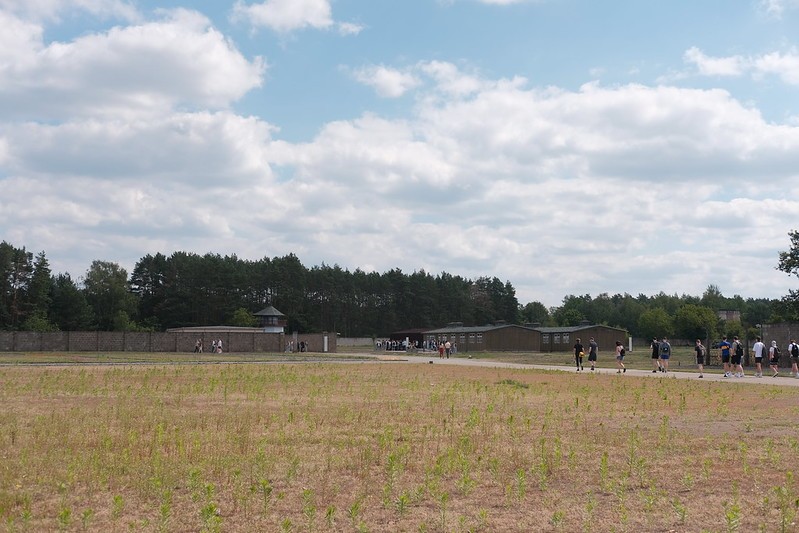
The view toward the barracks where Jews, arrested after Kristallnacht, were held by the Nazis in Sachsenhausen (Lev Gringauz/TC Jewfolk)
Sachsenhausen was an experimental grounds for the methods that would torture and destroy European Jewry in the Holocaust, as the Nazis toyed with different ways to mass murder – various ways of shooting people to death, early gas chambers and vans – and developed the most efficient layouts for imprisoning, working, and starving people to death.
Walking around the flat plains of the camp, and seeing execution pits and the small crematorium, was humbling to the group of teachers Croone was a part of: The Power of Place educational trip run by the Jewish Community Relations Council of Minnesota and the Dakotas. The trip is a joint venture with Humanus Network, a Holocaust education consulting organization.
“I thought that I was pretty well versed in what happened during the Holocaust, and I can see bits of it…connection points of where my knowledge ends and where it begins,” said Alex Coffroth, a middle school teacher in Harrisburg, S.D. “But I had nowhere near the depth. That’s what I’ve received so far [on this trip]. It’s far and away more than I could have hoped for.”
The visit to Sachsenhausen came on the Berlin-based second leg of the Power of Place trip early last week. Here, the history of the Nazis is front and center at countless memorials spread across the city, including the prominent Holocaust memorial of large blocks of stone and uneven ground in central Berlin, and the brass stumbling stones just about everywhere noting the places that Jews lived before the Holocaust – and their eventual fate.
There are also lesser-known, but just as impactful, memorials, including a neighborhood in which artists set up signs on light poles that show excerpts of Nazi anti-Jewish laws. Thus, every day, residents come face-to-face with laws like the banning of Jewish participation in choirs, the removal of Jewish rental rights, and the mandate that Jewish men add “Israel” and Jewish women add “Sara” to their names to be more recognizable as Jews. Through these insidious laws, the Nazis ostracized and removed Jews from public life, setting the stage for mass murder away from the eyes of the German public.
The level of memorialization “feels like what I would expect [if I was] going to a museum back in the States,” Coffroth said. “Then I have to have the realization that this is the actual place [where] these things occurred.”
The group visited locations like the Altes Museum and Lustgarten, formerly part of the imperial Prussian estate, which later became a prominent rally location for the Nazis in central Berlin. Here, Hitler delivered diatribes against Jews and other enemies of the state, propped up on a makeshift platform in front of the Altes Museum columns and facing the Nazi masses.
Further south, the Power of Place group encountered a contrast to their visits of the death camp Treblinka and the concentration camp Sachsenhausen: There, away from Berlin, the Nazis committed mass murder. But here, across a few blocks, were once the headquarters of the Nazi Gestapo and Schutzstaffel (SS) divisions – where the Holocaust was organized and directed from.
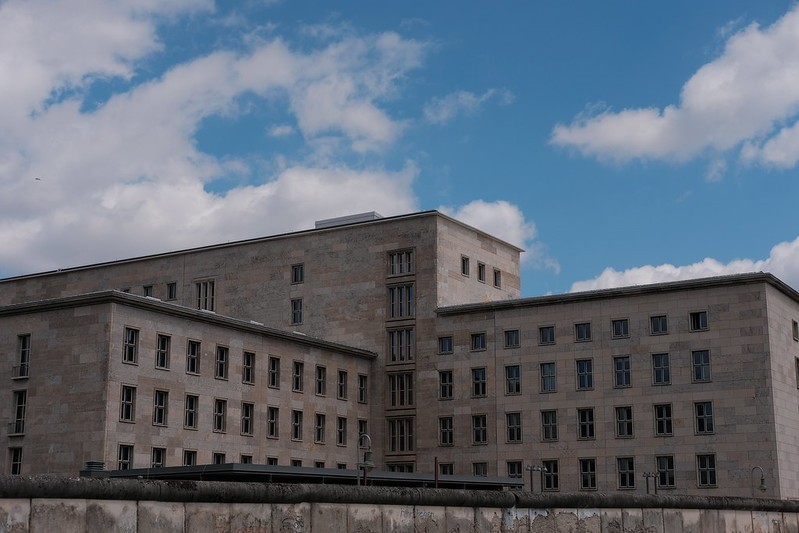
The Detlev-Rohwedder-Haus, originally built for Hermann Goring, one of the highest-ranking Nazis of the Third Reich, with remains of the Berlin Wall in the foreground (Lev Gringauz/TC Jewfolk)
The headquarters were demolished in WWII, and today houses the Topography of Terror museum that showcases the inner workings of Nazi brutality. But across the road still stands the Detlev-Rohwedder-Haus, a massive office building originally built for top-ranking Nazi Hermann Goring, who signed off on the mass murder of all Jewry.
After the war, the office space – apparently called the “most feared building in Berlin” – was used by the Communist government of East Germany, and today houses the German equivalent of the Internal Revenue Service (a sign, perhaps, that a German sense of irony is severely lacking).
“Mostly what we saw in Berlin was the inner workings of this machine, the gigantic, monolithic buildings…with all the different structures that the Nazis had in order to run this empire,” Coffroth said.
Other contrasts were also deeply felt by the teachers. After visiting Sachsenhausen, the Power of Place group saw Platform 17, a train platform tucked further away from central Berlin that was the most prolific deportation point for Berlin’s Jews. Mostly, they were deported either to the death camp Auschwitz or to the concentration camp Theresienstadt – which itself was a transit point to Auschwitz.
Being “out of the way” was entirely the point, as the Nazis tried to hide what they were doing to the Jews, and give the residents of Berlin plausible deniability when it came to knowledge of the Holocaust.
Today, it’s a barren-looking set of unused train tracks surrounded by trees, and a platform-turned-memorial (created only in 1998) with a chronological listing of deportations, locations, and numbers of Jews sent on each transport.
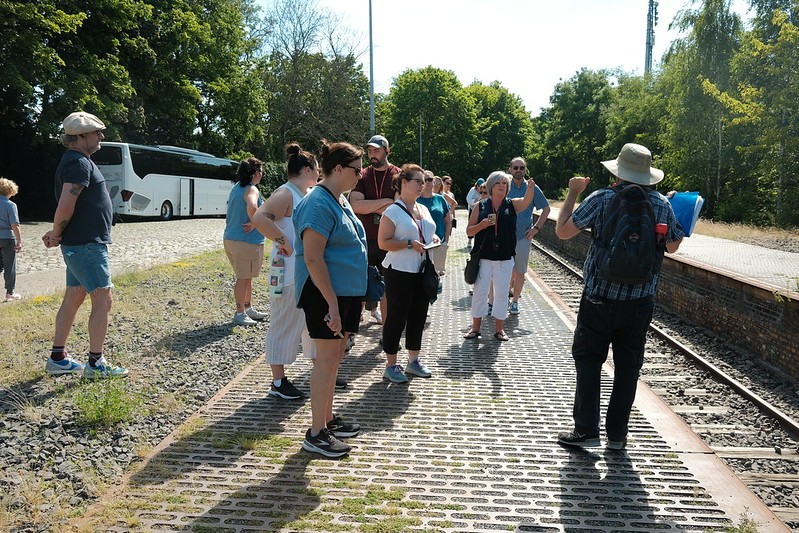
The Power of Place group stands at Platform 17 (Lev Gringauz/TC Jewfolk)
“The heat was so oppressive, it was just blazing hot,” said Marlana Benzie-Lourey, a high school teacher in Pine County, Minn., of the midday visit to Platform 17. “This forgotten nature of [the platform], that it only recently became a memorial – and even though it’s a memorial, you still kind of creep up on it, you know, you have to find it, it’s behind the trees.”
But a short bus ride away, Benzie-Lourey and the rest of the group visited the Wannsee House, the lakeside mansion used by the SS for all manner of meetings – including, in 1942 the Wannsee Conference, in which Nazi authorities coordinated their approach to the Holocaust.
Wannsee has “the most lovely, wealthy, luxurious, posh homes all around this lake with people canoeing and kayaking and little yachts floating down,” said Benzie-Lourey.
“It just turns your stomach because they’re in this most beautiful place. And [the Nazi officials’] task – that they all readily accept – is to coordinate the Final Solution,” she said. “Who’s going to do what, and how this is going to work out, and to do it. So matter of factly after breakfast.”
While the villa seems large, the side room where the conference was held is deceptively, almost infuriatingly small. To an overactive imagination, it seems to be quietly mocking visitors. After all, the Nazis needed no larger space to address their simple issue with the mass murder of Jews: The logistics necessary for such work.
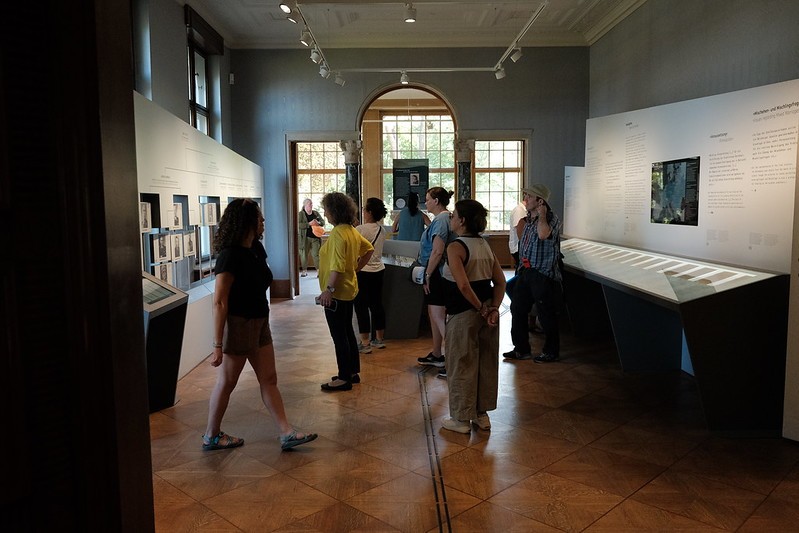
Teachers exploring part of the Wannsee House museum, standing in the room where the namesake conference took place (Lev Gringauz/TC Jewfolk)
“The arrogance and the hubris and the evil that just permeated that whole place, even while the breeze was blowing and it was so pretty, it was just very unsettling,” said Benzie-Lourey.
Today the villa is a museum to the conference, its aftermath, and the challenges of Holocaust memorialization in Germany (for a time after the war, the Wannsee House was used as a children’s retreat, and only turned into a museum after years of pressure). Notably, the museum includes the fact that the Nazis tried to burn and destroy any record of the conference. Only one copy of the conference minutes was recovered.
While at times overwhelming, the mix of emotions that teachers encountered is, in some ways, the entire point of a trip like this. Now equipped with their personal experiences, teachers have a deeper way to engage their students while teaching about the Holocaust.
“Students are like anybody, they want to hear the stories,” said Benzie-Lourey. “That’s more powerful than any photos you could show or any YouTube clips or anything else. Just being able to say, ‘I was there. This is how I felt. This is the pain I felt. This is what it looks like [through] my eyes.’”
For Croone, the St. Paul teacher, now comes a new challenge: How to organize all that she’s learned into her classes.
“I’ve been trying to think about, how am I going to incorporate all this learning? Because my head is just buzzing, it’s like, ‘oh, I’ve got all these great ideas,’” Croone said.
Croone is also trying to bridge the history of the Holocaust with the experiences some of her students have today, like fleeing dangerous areas and warzones as refugees and, in the midst of that, experiencing trauma and loss.
She wants to “give the kids current knowledge of what’s happening in the world as far as camps and persecution goes, but to also bring back the history, so that that phrase – ‘never forget, never again’ – always comes through,” Croone said.
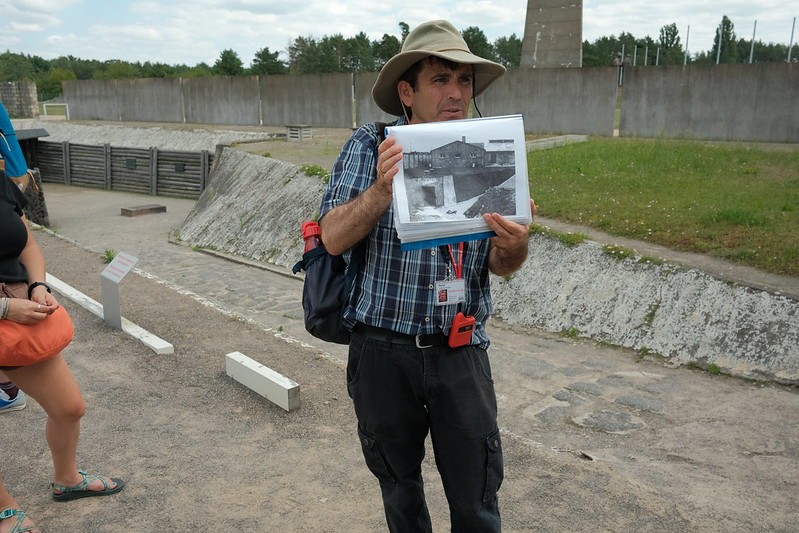
Tour guide Ronen Altman Kaydar shows a historical photo of the pit behind him, the location in Sachsenhausen where masses of prisoners, including many Soviet soldier POWs, were shot and murdered (Lev Gringauz/TC Jewfolk)
“You need to talk about atrocities, you need to talk about the bad things that are going on, so that you understand: Where do you stand in the situation? And how can you work to prevent it in the future?” she said.
Having taught about the Holocaust to middle schoolers for many years, it can sometimes feel futile. Many middle schoolers are still too young and self-absorbed to have a sense of the world, and why learning this kind of history is important.
But Croone has also been around long enough to see that the seeds of Holocaust education do often grow.
Students, as they get older, “do remember, and they do think about it, and then they’re like, ‘I need to do something,’” Croone said. That inspires “personal action for themselves as they transition into their real lives.”





















What a story! I hope I hear more from you, Kirsten. What an incredible experience. Bless you for all you do to teach and lead your student. We must remember. ❤️
The problem is that these are intelligent people who are open to the truth. How to reach the Holocaust deniers is important and more difficult. Time, I believe, is short as we get further and further away from those years. We must never forget how easily the nazis were able to accomplish their goals. We must be vigilant and even though it now seems to be a cliche, we must NEVER FORGET.